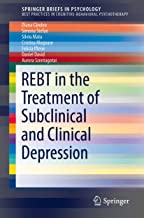Minor depressive disorder
The essential feature of minor depressive disorder includes one or more depressive episodes that mimic a major depressive episode in length, but fewer symptoms are present and there is less impairment than in major depression. A depressive episode must involve either a sad or depressed mood or loss of interest in almost all previously enjoyed activities.
Cluster Number:
Wiki Number: PW122
Diagnosis: Minor Depressive Disorder
US Patients:
World Patients:
Sex Ratio:
Age Onset:
Brain Area:
Symptoms: 2 of 4 depression symptoms for 2 weeks:loss of interest, depressed mood; insomnia, weight loss, feel worthless, suicidal thoughts
Progression: The Diagnostic and Statistical Manual of the American Psychological Association, 5th ed., 2013 no longer includes this diagnosis.
Causes:
Medications: antidepressants
Therapies: CBT
Youtube Video: Minor Depressive Disorder
– Medical Condition Information
Amazon or Library Book:
REBT in the Treatment of Subclinical and Clinical Depression
Click the book to link or order from Amazon.

